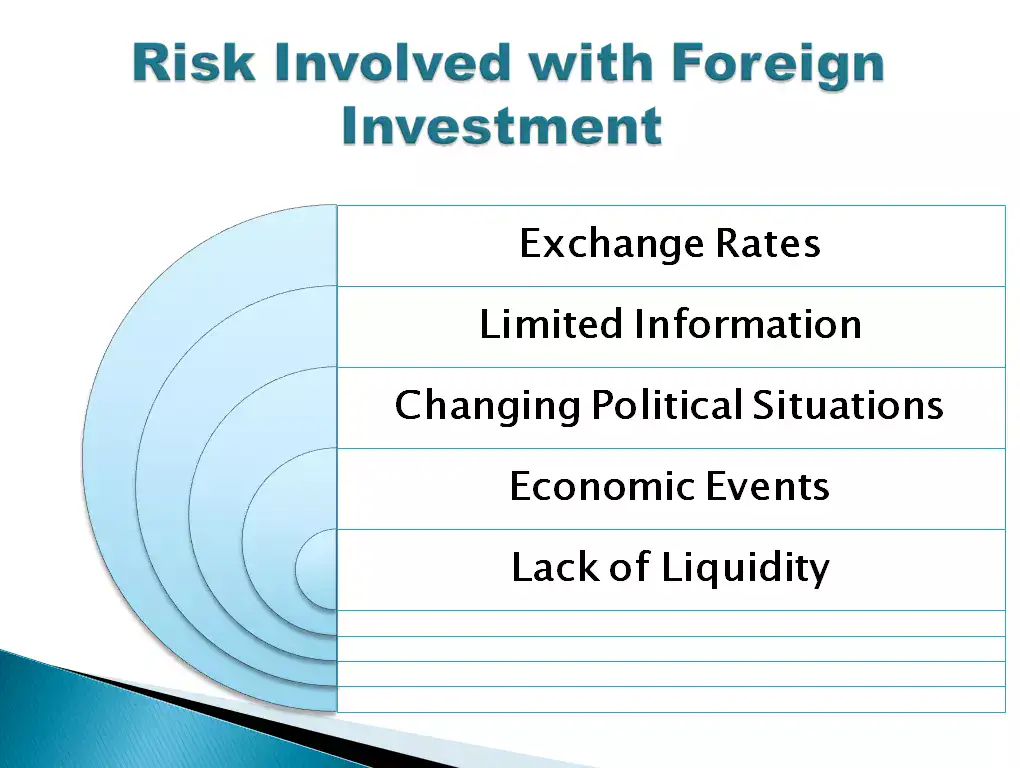What is Foreign Investment?
Foreign investment refers to the act of investing money in a country by people or entities from another country. This practice plays an important role in the global economy, as it fosters economic growth, creates employment opportunities, and facilitates the transfer of knowledge and technology across borders.
A firm requires foreign capital and technology to expand its operations in international markets. Foreign investment can play an important role in attaining this objective. Thus, it can directly or indirectly help in earning foreign capital. A nation makes foreign investments by exchanging assets and securities with a company based in another nation. This type of investment facilitates diversification and promotes economic growth. Investors can use various instruments, such as Exchange Traded Funds (ETFs), to invest in international markets. American Depository Receipts (ADRs), mutual funds, etc. The majority of investors prefer to engage in foreign investment by investing their capital in foreign markets. For example, along with having domestic stocks and bonds, one can purchase mutual funds shares and stocks from a foreign country.
Decisions related to foreign investment, whether defensive or aggressive, generally involve strategic, behavioural, or economic reasons. Multinational companies may decide to invest internationally to increase their market share. Even if the purpose of investing abroad is non-financial, the long-term survival of the MNCs needs to check the feasibility of the project.
Types of Foreign Investment
Foreign investment is of the following two types:
1) Foreign Direct Investment (FDI): Foreign direct investment (FDI) refers to acquiring ownership in a business enterprise in one country into a company operating in another country. This investment may take in several ways like purchasing or constructing a new plant abroad or enhancing its infrastructure by adding machinery, factories etc. The company that makes direct investments has a significant degree of power and control over the workings of the invested company.
2) Foreign Indirect/Institutional Investment (FII): In foreign institutional investment the investor does not have lasting interest and control over the enterprise. This form of investment is short-term in nature and is easy to operate. These types of investments involve buying debt (bonds) or equity instruments (stocks) of a foreign organisation.
Flows of Foreign Investment
The need for foreign capital across different sectors has increased due to industrialisation since 1991 Foreign capital either in the form of direct or indirect investment is necessary for the growth of the Indian economy. These investments are important for developing basic economic infrastructures like seaports, roads, warehouses, railways, insurance and banking services, etc.
Computer software and hardware, construction activities, services and telecommunication, were the sectors that poll large amounts of foreign investments. The main sources of foreign direct investment (PD) include some developed countries like the U.S.A. UK, France, Germany, Singapore, Japan, Mauritius, Netherlands, South Korea, and Switzerland. The most common and popular route nowadays of making investing in India is through FDL Presently, in India FDI plays a major role in more than 63 zones (regions). Whereas, foreign direct investment is restricted to a few sectors of the economy to protect the nation’s interest and security. The Government of India reserves some zones for the public sector.
Foreign Investment role
Foreign Investment plays an important role in India’s growth dynamics. There exist several examples of the benefits of FI in India. FI in the retail sector holds immense potential to expand markets by reducing transaction and transformation costs of business operations. The implementation of advanced supply chains can achieve it. This, in turn, benefits both consumers and suppliers (farmers). Embracing FI can also result in net gains in employment at the aggregate level.
India has recently liberalised its FDI policy and decided to allow 100 per cent international investment in the single-brand retail segment. Reforms to industrial policies have brought about significant reductions to requirements regarding licensing done away with restrictions related to expansion and made it easy to use international technology. The real estate sector has performed well in recent times and a significant portion of its success can be attributed to the relaxed regulations on foreign investment and the robust performance of the economy. The Indian Government has been trying hard to do away with the FDI caps for the majority of the sectors but there are still critical areas like retailing and insurance where much thought needs to be given before allowing further Foreign Investment.
Related Articles:
- nature of business meaning
- nature of international business
- scope of international marketing
- determinants of economic development
- nature of capital budgeting
- nature of international marketing
Examples
Foreign Investment in India increased to 3509 USD million in May of 2015 from 2721 USD million in April of 2015. Foreign Investment in India averaged 1076.20 USD million from 1995 until 2015, reaching an all-time high of 5670 USD Million in February 2008 and a record low of 60 USD Million in February 2014. The Reserve Bank of India reports Foreign Investment in India.
According to the latest World Investment Report 2017 by the United Nations Trade and Development Agency, India has made remarkable progress in attracting Foreign Investment. In 2016, India’s efforts propelled it to the 9th position, marking a significant improvement in its ranking. This achievement is particularly noteworthy considering the global decline in FDI inflows during the same period.
Whereas in 2016, the United States maintained its position as the top host country for foreign investment (FDI) and strengthened its position as a leading destination for global capital. Which attracted an impressive inflow of a surprising $391 billion. Meanwhile, the United Kingdom experienced an extraordinary boom in foreign investment that increased from $33 billion in 2015 to $254 billion in 2016. On the other hand, India, the world’s second most populous country, saw a slight increase of 1% in FDI, reaching $44.5 billion in 2016.
According to a survey conducted by Unctad in early 2017, the economic situation in developing Asia emerged as the most influential macroeconomic factor influencing foreign investment. Simultaneously, the United States, China, and India continued to be the preferred FDI destinations among top executives.
FDI inflows reached an unprecedented $55.6 billion for the fiscal year ending March 2016, which was a record. In 2016-17, witnessed an even more substantial surge in FDI inflows, soaring to an impressive $60.08 billion.
Advantages of Foreign Investment
Foreign investment can provide several unique benefits. Some of them are as follows:
1) Gaining Access to Foreign Markets
Foreign investment can be an effective way to enter a foreign market. There are many countries which prohibit foreign companies from entering their local markets. Such markets can be explored with the help of entry modes like joint ventures and mergers.
2) Potential for Growth
Outward investment also provides opportunities for growth and development for the investing company. It includes the identification of countries which are in their developing phase and require FDI intensively. Successful identification and investment in such regions may bring in a significant return on investment.
3) Reduction in Production Cost
Foreign investment may reduce the cost of production if the host country has cheap labour and flexible policies. For example, shoe and clothing industries reduce their costs of production by shifting their manufacturing units to developing countries.
4) Consumers Gain
Consumers can also benefit from overseas investment. In industry, if international investment results in innovation or development of the product, the benefit of new or better product quality is enjoyed by the consumers. On the other hand, if the investment reduces costs, consumers can enjoy products at low cost.
Risk Involved with Foreign Investment
As foreign investment provides benefits to investors in the same way it also carries certain risks, which are as follows:

1) Exchange Rates
Exchange rate risk is likely the most significant risk that a company faces while practising foreign investment. While investing internationally the investing company has to convert its domestic currency into the country currency in which it is investing, and after completing the investment the returns are converted and evaluated based on the domestic currency. This conversion poses a risk for the investing enterprise due to differences in the exchange rate currencies. The company’s investments may not be as beneficial as expected if the value of the host country’s currency goes up against the dollar’s value. Therefore, the investing firm must ascertain the stability of the country’s currency before making any investments.
2) Limited Information
Information regarding financial statements and other policies is required by the company while making the overseas investment to determine the soundness of the investment. Acquiring this information might be difficult for the foreign country, as the norms and regulations of foreign countries might be different from those of the investors’ country. Thus, most foreign investments involve risk as they are made based on recommendations rather than based on concrete financial data.
3) Changing Political Situations
Several unanticipated political factors of foreign countries may influence the investment decisions of the investing company. Unlike the developed countries, there are many countries where the central government is not stable. The changes brought by the new government and their effect cannot be foreseen by foreign investors.
4) Economic Events
As the economic environment of a country is always changing, these changes can have unfavourable effects on the investments made in that country. International investors can suffer huge losses if that country faces economic downfall.
5) Lack of Liquidity
Foreign investors face difficulty in liquidating their foreign security while investing internationally. Investors prefer to have the option to sell their security, but it is generally difficult for them to find buyers to sell their offerings. Foreign investors may have to offer heavy discounts to the buyers if they need money.
